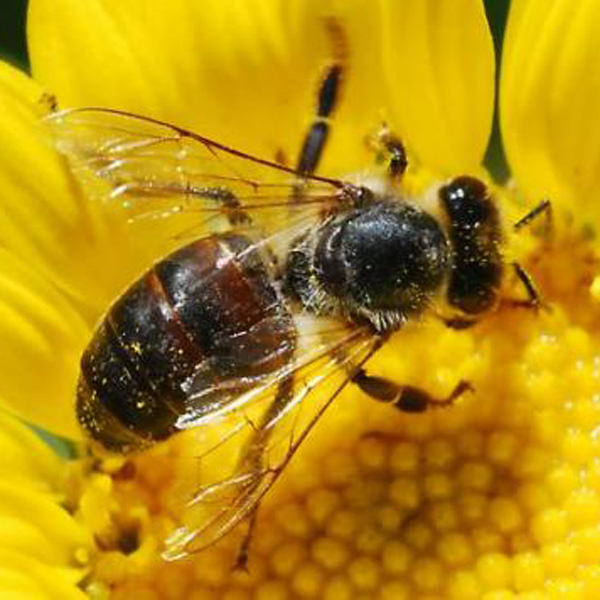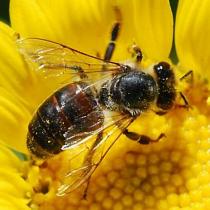Do aliens preside over bee colony destruction?
According to Dr. Michael Salla, there is a Military Extraterrestrial Industrial Complex or MIEC. Dr. John Lash suggests than lower dimensional entities rather than "Extraterrestrials" are piloting human vessels that are presiding over the destruction of our planet Earth. The ancient Pagan Gnostics referred to those lower dimensional entities as "Archons" [video below]. Does Dr. Lash's insights explain worsening negligence by elites on environmental issues?
(Mercola.com) -- For several years now, scientists have been struggling to determine why bee colonies across the world are disappearing—a phenomenon dubbed colony collapse disorder (CCD).
As reported by Dan Rather, the US has recently experienced the highest loss of honeybee populations so far, with most of the nation’s beekeepers losing anywhere from 50 to 90 percent of their bee population.
Honeybees are perhaps one of the least recognized workers in the agricultural industry. They contribute $15 billion in annual agriculture revenue to the US economy alone, as a full one-third of the American food supply depends on them pollinating crops.
Just about every fruit and vegetable you can imagine is dependent on the pollinating services of bees. Apple orchards, for instance, require one colony of bees per acre in order to be adequately pollinated. So, unless the mysterious disappearance of bees is reversed, major food shortages could result.
California Almond Orchards Threatened by Bee Loss
As discussed in Dan Rather’s report, 80 percent of the world’s almonds come from California’s central valley, an 800,000 acre area of almond orchards that are 100 percent dependent on bees pollinating the trees. Surprisingly, almonds are the number one agricultural product in California.
Once a year, in late winter, 1.5 million bee hives from around the country are delivered to these orchards where the bees’ pollination efforts take place over the course of just a few days. It’s the largest mass-pollination effort in the world.
This year, however, the unthinkable happened. Many of the 6,000 orchard owners simply could not find enough bees to pollinate their almond trees, at any price... One of the beekeepers featured in Rather’s report is John Miller, President of the California state Beekepers Association. His family has tended bees since 1894.
Of the 11,000 hives brought to California by Miller, hundreds of hives turned out to be dead when opened up. According to Miller, “the past 30 years have been tumultuous with 40 percent of the national herd dying or dead.”
Another fourth generation beekeeper named Anderson lost 70 percent of his hives this year. Yet another outfit lost 100 percent of his bees...
Fortunately, unsurpassed efforts that included persuading beekeepers as far away as Florida to ship their bees cross country, delayed bloom, and unseasonably good weather thereafter allowed almond growers to dodge the bullet—this year—despite having fewer and weaker-than-ever hives...
This narrowly-achieved success may lead some to reach the mistaken conclusion that beekeepers’ concerns are overblown.
Don’t be fooled. One beekeeper goes so far as to say he believes the beekeeper industry is doomed and cannot survive for more than another two to three years unless drastic changes are implemented...
What’s Causing Bees to Die?
Proposed culprits of bee colony collapse disorder include:
-- Pesticides and insecticides—Nicotinoids such as Imidacloprid and Clothianidin kills insects by attacking their nervous systems. These are known to get into pollen and nectar, and can damage beneficial insects such as bees.
-- Malnutrition/Nutritional deficiencies—Many beekeepers place the hives near fields of identical crops, which may result in malnutrition as the bees are only getting one type of nectar. Essentially, this theory is identical to that of human nutrition; we need a wide variety of nutrients from different foods. If you keep eating the same limited range of foods, you can easily end up suffering from nutritional deficiencies. Poor nutrition suppresses immune function, making the bees far more susceptible to toxins from pesticides, viruses, fungi, or a combination of factors that ultimately kill them.
-- Viruses and fungi—There's even the possibility that some new form of "AIDS-like" viral infection is affecting the bees.
-- Electromagnetic fields (EMFs)—Researchers have discovered that when a cellular phone is placed near a hive, the radiation generated by it (900-1,800 MHz) is enough to prevent bees from returning to them, according to a study conducted at Landau University several years ago.1
This result was duplicated in 2009 by Sainuddeen Pattazhy, a researcher and dean in the department of zoology at SN College, Punalur, Kerala. His experiments showed that microwaves from mobile phones appear to interfere with worker bees' navigation skills. When cell phones were placed near beehives, the hives collapsed completely in five to 10 days. The worker bees simply failed to return home.
More recently, a study published in 2011 found that the presence of microwaves from cell phones have a dramatic effect on bees, causing them to become quite disturbed.
Lack of natural foraging areas—Mass conversions of grasslands to corn and soy in the Midwest has dramatically reduced bees’ natural foraging areas
EPA Blamed for Failure to Protect Bees
A general consensus among beekeepers is that the bee die-offs are most definitely related to toxic chemicals. Increasingly, a systemic type of pesticide called neonicotinoids is being blamed for bee die-off’s. Neonicotinoids are now used on most of American crops, especially corn. This newer class of chemicals is applied to seeds before planting, allowing the pesticide to be taken up through the plant’s vascular system as it grows. As a result, the chemical is expressed in the pollen and nectar of the plant.
These insecticides are highly toxic to bees because they are systemic, water-soluble, and pervasive. They get into the soil and groundwater where they can accumulate and remain for many years and present long-term toxicity to the hive.
Neonicotinoids affect insects' central nervous systems in ways that are cumulative and irreversible. Even minute amounts can have profound effects over time. One of the observed effects of these insecticides is weakening of the bee's immune system. Forager bees bring pesticide-laden pollen back to the hive, where it's consumed by all of the bees. Six months later, their immune systems fail, and they fall prey to secondary, seemingly "natural" bee infections, such as parasites, mites, viruses, fungi and bacteria.
The disappearance of bee colonies began accelerating in the United States shortly after the Environmental Protection Agency (EPA) allowed these new insecticides on the market in the mid-2000s. Last month, beekeepers and environmental groups filed a lawsuit against the agency over its failure to protect bees from these toxic pesticides.
Meanwhile, France has banned Imidacloprid for use on corn and sunflowers after reporting large losses of bees after exposure to it. They also rejected Bayer´s application for Clothianidin, and other countries, such as Italy, have banned certain neonicotinoids as well.
The EPA acknowledges that “pesticide poisoning” may be one factor leading to colony collapse disorder, yet they have been slow to act to protect bees from this threat. The current lawsuit may help spur them toward more urgent action, which is desperately needed as the food supply hangs in the balance.
In March, according to Dan Rather’s report, the EPA sent Jim Jones, overseer of the Office of Chemical Safety and Pollution Prevention, to talk to California almond growers and beekeepers. But although beekeepers said Jones got the message that bees are in serious trouble, they were dismayed by the fact that he seemed more interested in finding new places for bees to forage rather than addressing the issue of toxic pesticides...
As usual, at the core of the problem is big industry, which is blinded by greed and enabled by a corrupt governmental system that permits the profit-driven sacrifice of our environment. Unfortunately, this motivation reflects an extreme shortsightedness about the long-term survival of the human race, as well as of our planet. Clearly, if the goal of pesticides is to increase food yield to more easily feed 7 billion human beings, this goal falls flat on its face if it leads to the collapse of our food chain.
Do You Trust Monsanto to Solve the Bee Colony Collapse Problem?
Another forerunning theory of colony collapse disorder (CCD) is that it's being caused by genetically engineered crops—either as a result of the crops themselves or the pesticides and herbicides applied on them, such as Roundup. In one German study, when bees were released in a genetically engineered rapeseed crop, then fed the pollen to younger bees, scientists discovered the bacteria in the guts of the young ones mirrored the same genetic traits as ones found in the GE crop, indicating that horizontal gene transfer had occurred.
Chemical companies like Monsanto are clearly seeking to take as much control of the food supply as possible by controlling virtually every aspect of crop production, so research implicating their business as the cause of bee die-offs would definitely cause harm to the company's bottom line. Monsanto has received increasing amounts of bad publicity over their potential role in the devastating demise of bees around the globe.
To better field such lines of inquiry, the company appears to have taken measures to control the direction of the research into their products' effect on bees by purchasing one of the leading bee research firms – one that, conveniently, lists its primary goal as studying colony collapse disorder. Monsanto bought the company, called Beeologics, in September 2011, just months before Poland announced it would ban growing of Monsanto's genetically modified MON810 maize, noting, poignantly, that "pollen of this strain could have a harmful effect on bees.”
Comments
There are 0 comments on this post













